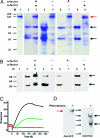A role for a complex between activated G protein-coupled receptors in yeast cellular mating
- PMID: 17369365
- PMCID: PMC1838501
- DOI: 10.1073/pnas.0608219104
A role for a complex between activated G protein-coupled receptors in yeast cellular mating
Abstract
Cell-cell fusion is a fundamental process that facilitates a wide variety of biological events in organisms ranging from yeast to humans. However, relatively little is actually understood with respect to fusion mechanisms. In the model organism Saccharomyces cerevisiae, mating of opposite-type cells is triggered by pheromone activation of the G protein-coupled receptors, alpha-factor receptor (Ste2p) and a-factor receptor (Ste3p), leading to mitogen-activated protein kinase signaling, growth arrest, and cellular fusion events. Herein we now provide evidence of a role for these receptors in the later cell fusion stage of mating. In vitro assays demonstrated the ability of the receptors to promote mixing of proteoliposomes containing phosphatidylserine, potentially based on a pheromone-dependent interaction between Ste2p and Ste3p that was confirmed by tandem affinity purification and cellular pull-down assays. The cellular mating activity of Ste2p was subsequently probed in vivo. Notably, a receptor-null yeast strain expressing N-terminally truncated Ste2p yielded a phenotype demonstrating wild-type signaling but arrested mating. The arrested prezygotes showed evidence of some cell wall erosion but no membrane juxtaposition at the fusion site. Further, in vitro analyses correlated this mutation with loss of the interaction between Ste2p and Ste3p and inhibition of related lipid mixing. Overall, these results support a role for a complex between activated yeast pheromone receptors in later cell fusion stages of mating, possibly mediating events at the level of cell wall digestion and membrane juxtaposition before membrane fusion.
Conflict of interest statement
The authors declare no conflict of interest.
Figures




References
Publication types
MeSH terms
Substances
LinkOut - more resources
Full Text Sources
Molecular Biology Databases

